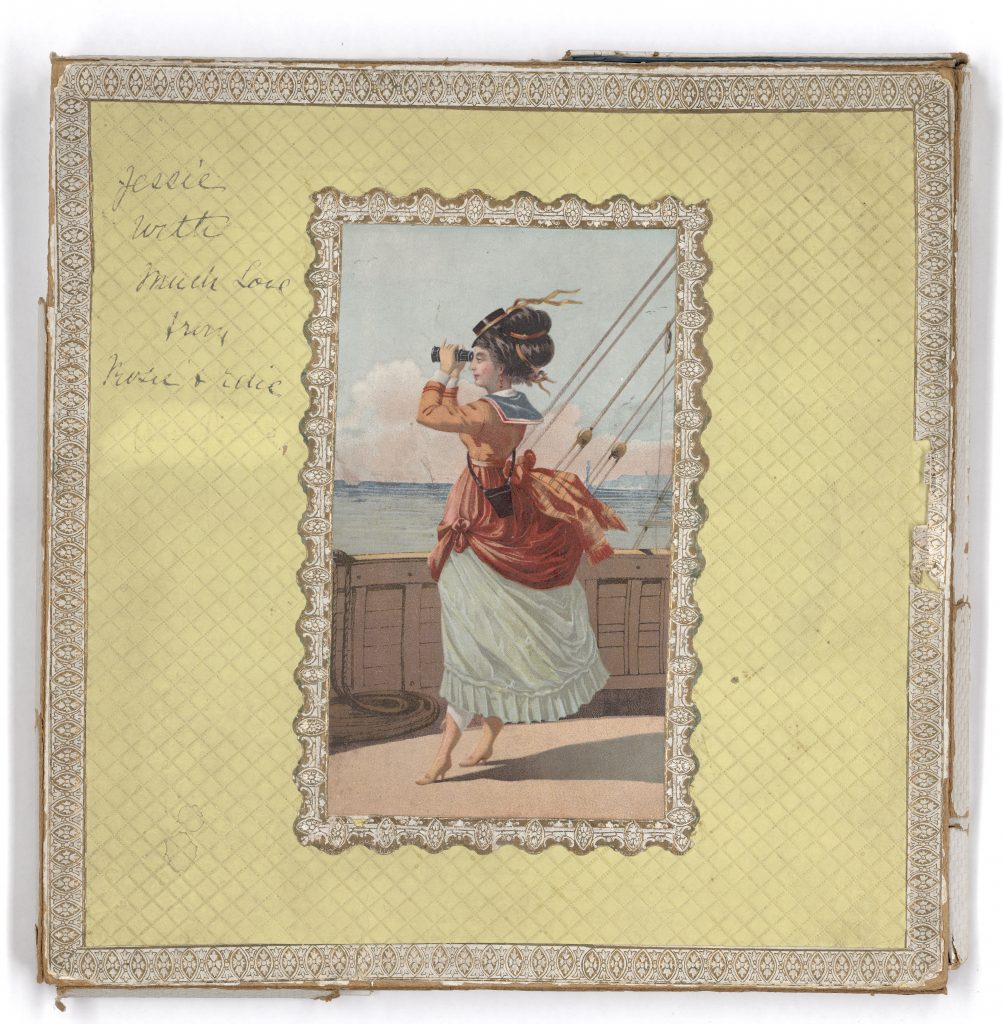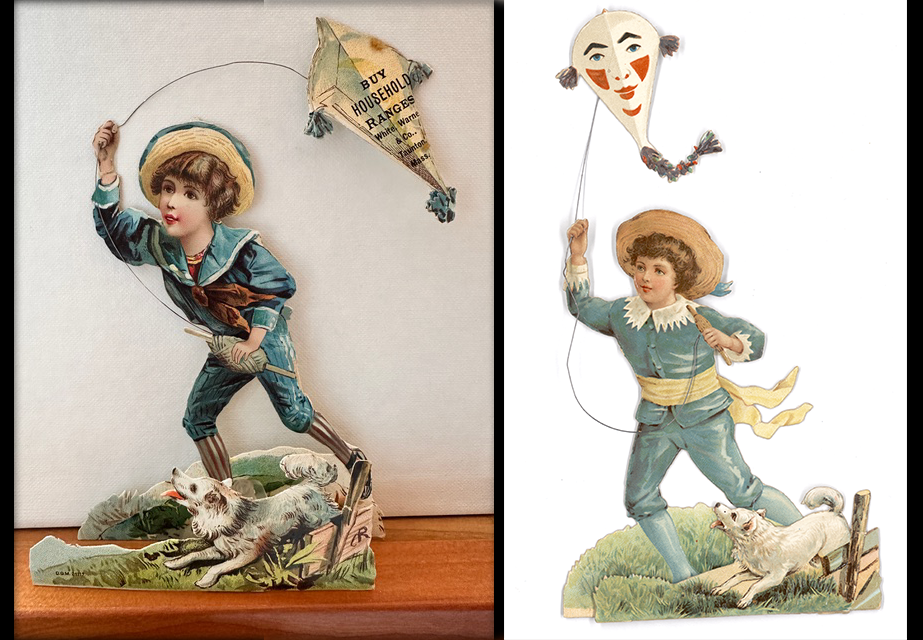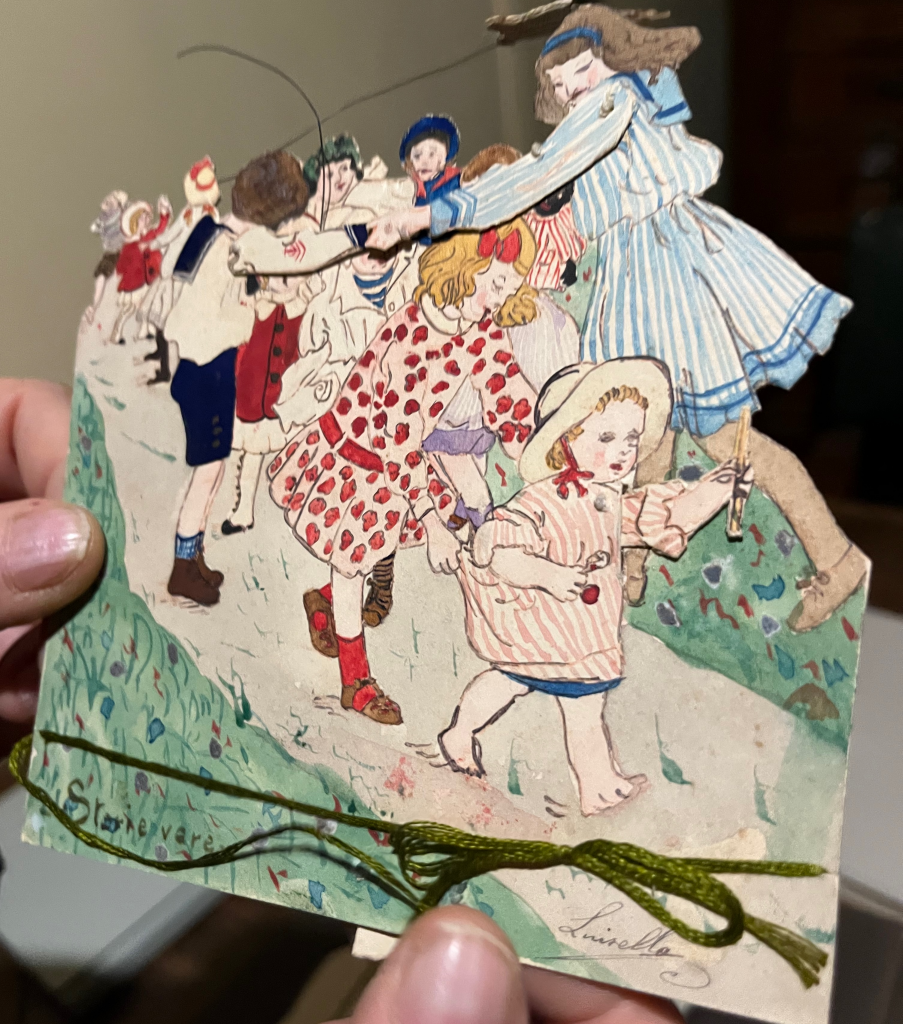By Dr. Jacqueline Reid-Walsh, Penn State College of Education & Jacquelyn Sundberg, Outreach Librarian, McGill
The “Flying Wonder” lives up to its name; this is a vibrant set of Victorian-era paper toys, animated with moveable flaps that allow them to stand on their own. When standing as they do (see photo 1 below), gravity and the slight movement of air breathes life and movement into these paper figures, sending a kite aloft, floating a balloon on the breeze, or a bird on the wing. These cards were produced by one of the powerhouses of British Victorian printing, Raphael Tuck and Sons. We have found instances of copycat versions across the Atlantic, and others in Italy as well. Follow along as we see how these small paper figures took flight to different corners of the globe.

The Raphael Tuck company was immensely prolific. Starting in London in 1870, Tuck and his sons specialized in “novelty” items that were designed in London but printed and assembled in Bavaria. In addition to movable books they produced cards, calendars, dolls, puzzles and so on (Mcgrath 24). These paper toys in the “Flying Wonder” set combine in a single card moveable elements of a flap and a wire along with images and script. Blair Whitton considers the set to be “simple novelty toys with action” (225). Collector Ian Alcock observes the set is aptly called “moveable” on the box since for instance you can set the ball or the doves in different positions (March 6, 24).

American collector Ellen G. K. Rubin – perhaps better known as the Pop-up Lady- has in her substantial collection of movable ephemera an example of a comparable doll whose kite advertises the “Household Ranges” of White, Warne, & Co, Taunton, MA. As Rubin notes, someone simply pasted the advertisement over the original image on the kite. While this example lacks the easily recognizable Tuck trademark, it was likely printed by Tuck and Sons, or by a competitor like McLoughlin Bros. in New York, who was well known for paper toys, dolls, games, and—perhaps less impressively—“British imports and Yankee piracies,” to quote Michael Patrick Hearn. The firm borrowed and reprinted editions and items from British printing houses with little regard for copyright. White, Warne, & Co. did something similar and took an opportunity for clever publicity with this paper kite flyer when they saw one!

This charming advertisement in Rubin’s collection shows that the Tuck dolls crossed the Atlantic, as Taunton is not far from Plymouth, MA. We question whether “The Flying Wonder” set could also have reached Italy. This question arises because we have seen examples of homemade movable paper toys made in early 20th century Italy employing wires to create movement.
We know that Tuck had offices in London, New York and Paris and that Tuck postcards and ephemera were certainly widely distributed and survive in large numbers. Newberry curator Will Hansen responded to our query and directed us to a comprehensive site devoted to Tuck ephemera with over 25, 000 items (email date feb. 9, 24).
Glancing at the site we see that some artifacts were published in three languages-German, English, and French at https://www.tuckdbephemera.org/items?q=wire
Searching the site using “wire” as a key term, we see wires used in different ways on cards and paper toys. These include ornamental appliqués such as a wire muzzle on a shaped card of a dog’s head, a birthday card using wire to hang miniature photos on the card, a birthday card using covered wire for a donkey’s tail, and so on. These are decorative additions. Unusual in our view is how delicate silver-coloured wire was used in the flying wonder cards to almost imperceptibly create motion— the wire is more tangible than visual and moves when the artifact is shifted. The paper toys also have a hinge that allows the figures to stand independently (like some paper dolls).
With this spread of items and languages, we speculate that the young school teacher Luisa Terzi could have been exposed to them due to being a protégé of the wealthy, cosmopolitan writer Paula Lombroso Carrara in Turin. Between 1913 and 1917 she created a set of handmade movable images based on the illustrations of four of Lombroso’s short stories for children. They are contained in four volumes and use different movable devices such as tabs, rivets, and silver wires attached to a floating object like a balloon (Vagliani catalogue 31-34.) We think the last kind of devices show affinity to the Tuck flying wonder toys.
To support this idea, we show the image below of Terzi’s paper toy held in the Foundation Tanredi di Barolo in Turin. Juxtaposing these with images of “The Flying Wonder,” the similarity of the flexible wire to enable movement will be immediately obvious.

Held in the Collection of Pop-App International Centre of the Tancredi di Barolo Foundation.
« Flying Wonder » et les jouets en papier de l’époque victorienne
Par Jacqueline Reid-Walsh, professeure en Éducation (Enseignement des langues et de la littératie, et Études des femmes) au College of Education de Penn State et Jacquelyn Sundberg, bibliothécaire, services et médiation, Livres rares et collections spécialisées, McGill
Dynamique ensemble de jouets en papier de l’époque victorienne, « Flying Wonder » porte bien son nom avec ses volets et articulations mobiles qui permettent à chaque jouet de tenir debout individuellement. Dans cette position (photo 1 ci-dessous), la gravité et l’air qui circule suffisent à insuffler vie et mouvement dans ces personnages de papier en soulevant un cerf-volant, en faisant flotter un ballon ou en soutenant les ailes d’un oiseau. Ces cartons ont été produits par un des plus grands imprimeurs britanniques de l’époque : Raphael Tuck and Sons. Des imitations de ces jouets ont été trouvées en Italie et même de l’autre côté de l’océan Atlantique. Suivez-nous dans les pas de ces petits personnages de papier qui ont parcouru le monde.

L’imprimeur Raphael Tuck était immensément prolifique. Fondée à Londres en 1870, l’entreprise s’est spécialisée dans les articles de fantaisie créés en Angleterre, puis imprimés et assemblés en Bavière. En plus de livres animés, l’imprimeur a aussi produit des cartes, des calendriers, des poupées, des casse-tête et bien d’autres choses (Mcgrath 24). Dans l’ensemble « Flying Wonder », on retrouve dans chaque carton des éléments mécaniques faisant appel à des volets et du fil, ainsi que des images et du texte. Blair Whitton a dit de cet ensemble qu’il s’agit de « jouets fantaisistes simples et animés » (225). Quant au collectionneur Ian Alcock, il fait remarquer qu’il est judicieusement indiqué « moveable » (mobile) sur la boîte puisqu’on peut notamment disposer le ballon ou les colombes de plus d’une façon (6 mars 2024).

Ellen G. K. Rubin, collectionneuse américaine d’objets animés mieux connue sous le nom de « the Pop-up Lady », possède dans son imposante collection de souvenirs un exemple d’une poupée semblable dont le cerf-volant arbore une publicité de cuisinière de White, Warne, & Co, Taunton, MA. Comme le souligne Mme Rubin, quelqu’un a simplement collé la publicité par-dessus l’image d’origine. Bien que cet objet ne possède pas les signes caractéristiques facilement reconnaissables de Tuck, il est très probable qu’il ait été imprimé par Tuck and Sons, ou par un concurrent comme McLoughlin Bros. à New York, bien connu pour ses jouets, poupées et jeux en papier et, peut-être moins glorieusement, selon les mots de Micheal Patrick Hearn, pour ses « importations britanniques et copies pirates amerloques ». McLoughlin Bros. a emprunté et réimprimé plusieurs éditions et articles d’imprimeries britanniques en se souciant très peu des droits d’auteur. White, Warne, & Co. a manifestement saisi l’occasion d’une publicité astucieuse avec ce cerf-volant en papier!

Ce charmant objet dans la collection d’Ellen G. K. Rubin témoigne de la traversée de l’Atlantique par des poupées Tuck puisque Taunton n’est pas très loin de Plymouth, MA. La question se pose également à savoir si « The Flying Wonder » s’est aussi frayé un chemin jusqu’en Italie, alors que nous avons vu des exemples de jouets mécaniques en papier artisanaux fabriqués au début du XXe siècle en Italie faisant appel à des fils pour animer des éléments.
Tuck and Sons avait des bureaux à Londres, à New York et à Paris, et ses cartes postales et souvenirs ont été largement distribués comme en témoigne le grand nombre de ces objets qui ont survécus. Will Hansen, conservateur à la bibliothèque Newberry, a eu la gentillesse de répondre à nos questions et de nous diriger vers un site exhaustif regroupant plus de 25 000 objets imprimés par Tuck (courriel du 9 février 2024).
En jetant un œil à ce site, nous avons découvert que certains avaient été publiés en trois langues : allemand, anglais et français. Une recherche sur le site avec le mot-clé « wire » (https://www.tuckdbephemera.org/items?q=wire) a fait ressortir plusieurs cartes et jouets en papier fabriqués avec des fils. On y retrouve notamment des éléments ornementaux en application comme une muselière tressée sur une carte en forme de tête de chien, des photos miniatures accrochées par un fil sur une carte ou un fil dissimulé relié à la queue d’un âne sur une carte d’anniversaire. Tous ces ajouts sont cependant décoratifs. Il nous apparaît donc inhabituel de voir comment les jouets de la collection Flying Wonder font appel à un délicat fil argenté pour créer un mouvement de façon presque imperceptible : le fil lui-même est plus tangible que visuel, et il bouge quand le carton est déplacé. Tous ces jouets en papier possèdent aussi une articulation qui permet à chaque personnage de se tenir seul debout (comme certaines poupées de papier).
Cette diversité de langues et d’objets nous amène à émettre l’hypothèse que la jeune institutrice Luisa Terzi a pu y être exposé puisqu’elle a été la protégée du riche auteur cosmopolite Paula Lombroso Carrara à Turin. Entre 1913 et 1917, elle a fabriqué à la main un ensemble d’images animées en s’appuyant sur les illustrations de quatre histoires pour enfants de Lombroso. On les retrouve dans quatre volumes et elles font appel à divers éléments mobiles comme des languettes, des rivets et des fils d’argent attachés à un objet flottant comme un ballon (Vagliani catalogue 31-34.) Ce dernier dispositif n’est pas sans rappeler ceux utilisés sur les jouets de l’ensemble Flying Wonder de Tuck.
Il suffit de regarder ces quelques images de jouets de papier fabriqués par Terzi dans la collection de la Fondation Tanredi di Barolo de Turin, et de les comparer à celles de l’ensemble « The Flying Wonder » pour que la ressemblance devienne évidente dans cette utilisation de fil souple pour créer un mouvement.

Conservé dans la collection du Centre international Pop-App de la Fondation Tancredi di Barolo.
Secondary references / Références secondaires
Alcock, Ian email March 6 2024
Hansen, Will email February 9, 2024
McGrath, Leslie This Magical Book: Movable Books for Children, 1771-2001 Toronto: Toronto Public Library, 2002
Vagliani , Pompeo Pop-App scienza, arte e gioco nella storia dei libri animati dall carta alle app Turin: Foundation Tancredi Di Barolo, 2019.
Whitton, Blair. Paper Toys of the World. Cumberland Maryland: Hobby House Press, 1986.












Leave a Reply
You must be logged in to post a comment.